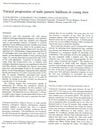Modeling the Dynamics of Human Hair Cycles by a Follicular Automaton
July 2000
in “
Proceedings of the National Academy of Sciences
”
TLDR The model accurately simulates human hair growth and hair loss patterns.
The study developed a follicular automaton model to simulate human hair cycle dynamics using data from 10 male volunteers over 14 years. It successfully replicated the transitions of hair follicles through anagen, telogen, and latency phases, highlighting that nonalopecic subjects had longer anagen phases. The model demonstrated that shorter anagen phases in alopecic subjects contributed to hair loss and allowed exploration of conditions leading to androgenetic and diffuse alopecia by simulating follicle death or miniaturization. The study emphasized the independence of each follicle and variability in anagen phase duration as crucial factors in hair cycle dynamics.





